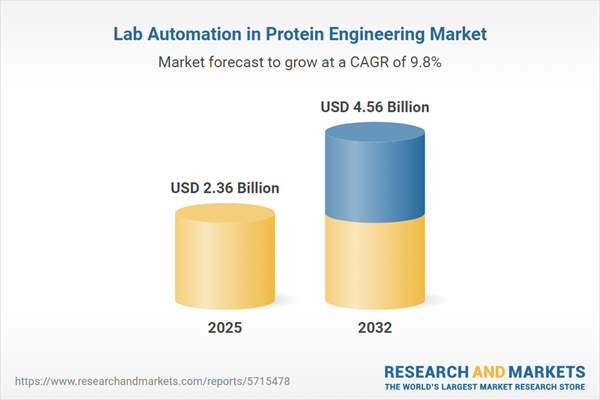Speak directly to the analyst to clarify any post sales queries you may have.
Lab automation in protein engineering is transforming how organizations approach scientific discovery and operational efficiency. Senior executives are leveraging automated workflows to stay adaptable in a rapidly evolving research landscape, ensuring that investments remain aligned with both business objectives and the latest technological advances.
Market Snapshot: Lab Automation in Protein Engineering
The lab automation in protein engineering market is experiencing steady growth, fueled by the drive for higher accuracy, scalability, and improved data reliability across modern research settings. In 2024, market value reached USD 2.15 billion and forecasts indicate expansion to USD 4.56 billion by 2032, at a 9.82% compound annual growth rate (CAGR). Organizations are increasingly deploying adaptive laboratory systems to meet complex scientific objectives alongside business needs. Investments in interoperable informatics now support advanced laboratory equipment and enhance workflow coordination across enterprise systems, helping companies anticipate and adapt to shifting research demands.
Scope & Segmentation
This comprehensive report guides executive decision-making with an organized analysis of the lab automation in protein engineering market, supporting targeted procurement and operational planning. Detailed coverage shows how innovation aligns with critical end-user objectives, creating measurable impact across the value chain:
- Product Types: Consumables such as reagents, plates, and pipette tips; a broad spectrum of instrumentation, from compact benchtop units to high-throughput systems; and software services developed for workflow and platform oversight.
- Automation Platforms: Biosensor systems for various analytical needs; micro- and nano-volume liquid handling devices; microplate readers for luminescence, absorbance, and fluorescence assays; and flexible robotic workstations enhancing research productivity.
- Applications: Enzyme engineering through directed evolution and rational design; specialized lead identification; advanced methods for protein expression and purification; and analytical capabilities including NMR and X-ray crystallography.
- End Users: Academic research units, biotechnology enterprises, contract research organizations, and pharmaceutical companies, all integrating advanced automation to accelerate innovation and output.
- Technologies: Acoustic liquid handling with both piezoelectric and ultrasonic options; magnetic bead separation encompassing paramagnetic and superparamagnetic solutions; and adoption of microfluidic systems for continuous and droplet-based workflows.
- Regions: Americas (with a specific focus on the US, Canada, Mexico, and Brazil); Europe, Middle East & Africa (featuring the UK, Germany, and France); and Asia-Pacific, with China, India, Japan, Australia, and Southeast Asia reflecting diverse adoption and regulation patterns.
- Companies: Thermo Fisher Scientific, Danaher Corporation, Agilent Technologies, PerkinElmer, Tecan Group, Sartorius AG, Hamilton, Eppendorf, Bio-Rad Laboratories, and QIAGEN, each contributing to advances in automation and shaping trends within the sector.
Key Takeaways for Senior Decision-Makers
- Automated research workflows are enhancing experimental reproducibility and meeting the increasing complexity of molecular investigations.
- The integration of robotics, biosensors, and secure cloud protocols is facilitating greater productivity and seamless collaboration between multidisciplinary teams.
- Modular laboratory setups and consistent data standards simplify project oversight, especially across distributed research sites.
- Technological innovation in microfluidics, acoustic technology, and AI-augmented analysis is advancing predictive capabilities and supporting regulatory compliance.
- Procurement strategies are now more closely aligned with evolving research needs, enabling organizations to respond rapidly to changes in the business and regulatory environment.
- Growing demand for adaptable and upgradable automation platforms is helping labs optimize infrastructure costs while supporting a diverse range of experimental requirements.
Tariff Impact: Strategic Responses to Regulatory Adjustments
Recent changes in U.S. tariff policy are prompting organizations within protein engineering to adjust sourcing practices for lab automation solutions. Many labs are forming expanded supplier networks and prioritizing materials produced within their regions. Contract agreements are being structured with consideration for cost transparency and price fluctuations. At the same time, manufacturers are modifying product portfolios to reflect local requirements, and research groups are reinforcing agreements aimed at supply chain reliability and predictable budgeting.
Methodology & Data Sources
This market analysis utilizes validated qualitative input from leaders in R&D and procurement, enriched by quantitative reviews from peer-reviewed articles, key industry publications, and technology patent patterns. A triangulation framework anchors the research, delivering evidence-based insights for executive consideration.
Why This Report Matters
- Enables executive teams to target technology investments while establishing strategic supplier relationships tailored to distinct regional demands and operational structures.
- Supports comprehensive financial planning and capital allocation, helping leaders remain agile in the face of shifting regulations and organizational adjustments.
- Guides organizations in developing resilient automation strategies essential for protecting competitive position and promoting long-term stability.
Conclusion
Lab automation is reshaping protein engineering by building resilient operations and supporting data-driven decisions. Strategic adoption ensures organizations are prepared for new challenges and equipped to sustain innovation momentum.
Additional Product Information:
- Purchase of this report includes 1 year online access with quarterly updates.
- This report can be updated on request. Please contact our Customer Experience team using the Ask a Question widget on our website.
Table of Contents
3. Executive Summary
4. Market Overview
7. Cumulative Impact of Artificial Intelligence 2025
List of Figures
Samples

LOADING...
Companies Mentioned
The key companies profiled in this Lab Automation in Protein Engineering market report include:- Thermo Fisher Scientific Inc.
- Danaher Corporation
- Agilent Technologies, Inc.
- PerkinElmer, Inc.
- Tecan Group Ltd.
- Sartorius AG
- Hamilton Company
- Eppendorf AG
- Bio-Rad Laboratories, Inc.
- QIAGEN N.V.
Table Information
| Report Attribute | Details |
|---|---|
| No. of Pages | 183 |
| Published | October 2025 |
| Forecast Period | 2025 - 2032 |
| Estimated Market Value ( USD | $ 2.36 Billion |
| Forecasted Market Value ( USD | $ 4.56 Billion |
| Compound Annual Growth Rate | 9.8% |
| Regions Covered | Global |
| No. of Companies Mentioned | 11 |









